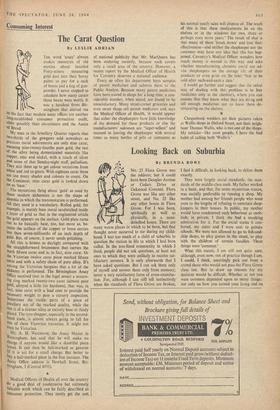Consuming Interest
The Carat Question
By LESLIE ADRIAN
THE word 'assay' always evokes memories of old
movies about bearded Forty-niners measuring gold dust into their horny palms to pay for a sack of beans and a keg of gun- powder. I never stopped to My man in the Jewellery Quarter reports that two-thirds of the gewgaws sold nowadays as Precious metal adornments are only nine carat, meaning nine-twenty-fourths pure gold, the rest of the alloy being domesticated materials like copper, zinc and nickel, with a touch of silver and some of that Sunday-night stuff, palladium. They mix them up to get colour variations from White and red to green. With eighteen carat there are too many shades and colours to count. On the Continent, nine carat gold is looked down on as 'base.'
The mysterious thing about 'gold' as used by these modern alchemists is not the shape of alembic in which the transmutation is performed. All they need is a vocabulary. Rolled gold, for example, is mainly base metal sandwiched inside a layer of gold so that in the engineered article the gold appears on the surface. Gold plate turns out to be basically base, too, but more so, be- cause the surface of the copper or brass carries less than seven-millionths of an inch depth of gold. But, of course, it never needs polishing. All this is honest as daylight compared with the straightforward brazenness that carries the mark fifteen carat and is, in fact, nine carat. Or the Victorian twelve carat piece marked fifteen carat and with a safety chain of pure alloy. It's among the Victorian bargains that a lot of the alchemy is performed. The Birmingham Assay Office received (not in the Icgal sense) a mourn- ing ring marked twenty-two carat (almost pure gold, alloyed a little for hardness), that was, in fact, nine carat with a lead core to provide the necessary weight to pass a cursory inspection. Sometimes the visible parts of a piece of jewellery are of the marked quality, while the test is of a coarser alloy or entirely base or thinly Plated. The tyro shopper, especially in the second- hand trade, is almost always going to fall for one of these Victorian travesties. It might not even be Victorian.
Mr. A. H. Westwood, the Assay Master in birmingham, has said that he will make no charge if anyone would like a doubtful piece tested. It can then be hall-marked as genuine (if it is so) for a small charge. But better to buy a hall-marked piece in the first instance. The Assay Office address is Newhall Street, Bir- mingham, 3 (Central 6951).
Medical Officers of Health all over the country do a good deal of unobtrusi't'e but extremely valuable work which can be fairly described as consumer protection. They rarely get the sort of national publicity that Mr. MacQueen has been enduring recently, because each covers only a small area of the country. However, a recent report by the Medical Officer of Health for Coventry deserves a national audience.
Every so often his department buys samples of patent medicines and submits them to the Public Analyst. Because many patent medicines have been stored in shops for a long time, a con- siderable number, when tested, are found to be unsatisfactory. Many street-corner groceries and even sweet shops sell patent medicines and, says the Medical Officer of Health, 'it would appear that either the shopkeepers have little knowledge of the demand for these products or else the manufacturers' salesmen are "super-sellers" and succeed in leaving the shopkeeper with several times as many bottles of pills or ointments as
his normal yearly sales will dispose of. The result of this is 'that these medicaments lie on the shelves or in the windows for two, three or perhaps even more years.' The result of that is that many of them 'break down' and lose' their effectiveness—and neither the shopkeeper nor the customer may have any idea that this has hap- pened. Coventry's Medical Officer wonders how much money is wasted in this way and asks whether manufacturing chemists could not ad- vise shopkeepers on the storage life of their products or even print on the label 'Not to be sold after such-and-such a date.'
I would go further and suggest that the safest way of dealing with this problem is to buy medicines only at the chemist's, where you can assume that they know what they are do:ng and sell enough medicines not to leave them de- teriorating on the shelves.
Chequebook wielders get their pictures taken at Wallis shops in Oxford Street, not their neigh- bour Thomas Wallis, who is not one of the shops. My mistake—like most people, I have the bad habit of calling both 'Wallis's.'


































 Previous page
Previous page